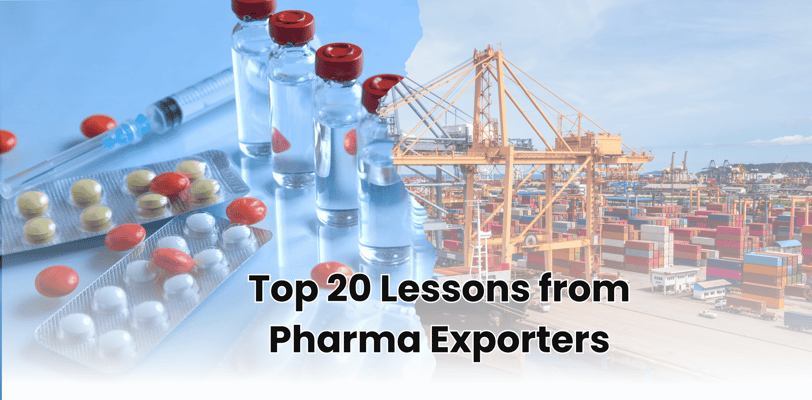Top 20 Lessons from Pharma Exporters
Pharmaceutical exports are the backbone of global healthcare, providing essential medications across the world. The strategies and practices of leading pharmaceutical exporters reveal invaluable lessons for businesses aiming to scale and succeed internationally. This blog highlights 20 key lessons drawn from the practices of renowned companies like Sun Pharma, Teva Pharmaceuticals, Pfizer, Novartis, Roche, Sanofi, Bharat Biotech, and others.
1/19/20252 min read


1. Prioritize R&D Investments
Continuous investment in research and development fosters innovation, enabling companies to produce cutting-edge drugs and therapies.
Example: Sun Pharma’s dedication to R&D has driven its leadership in specialty generics and complex formulations.
2. Understand Global Regulatory Frameworks
Complying with international standards ensures seamless market entry and sustained operations.
Example: Torrent Pharma’s expertise in regulatory compliance has secured its presence in regulated markets like the US and EU.
3. Build a Strong Supply Chain
An efficient and resilient supply chain ensures timely delivery and maintains drug efficacy.
Example: Bharat Biotech’s distribution of Covaxin globally demonstrates impeccable logistics management.
4. Leverage Strategic Partnerships
Collaborations with local distributors and manufacturers expand market reach and enhance efficiency.
Example: Teva Pharmaceuticals partners with regional distributors to strengthen its presence in emerging markets.
5. Embrace Market Diversification
Diversifying markets reduces dependency on specific regions and mitigates risks from economic or regulatory changes.
Example: Amneal Pharmaceuticals targets both developed and emerging markets to stabilize its revenue streams.
6. Invest in Digital Transformation
Leveraging AI, IoT, and blockchain enhances transparency, efficiency, and decision-making.
Example: Pfizer uses AI to streamline its supply chain and improve demand forecasting.
7. Focus on Patient-Centric Solutions
Developing therapies tailored to patient needs improves outcomes and builds brand loyalty.
Example: Roche’s precision medicine approach targets specific patient populations for better efficacy.
8. Prioritize Sustainability
Eco-friendly practices and sustainable packaging appeal to environmentally conscious consumers and regulators.
Example: Sanofi’s commitment to reducing carbon emissions aligns with global sustainability goals.
9. Combat Counterfeit Drugs
Deploy anti-counterfeiting measures like blockchain and QR codes to ensure product authenticity.
Example: Abbott’s serialization technology ensures product safety in global markets.
10. Maintain Quality Assurance
High-quality standards build trust among consumers and regulatory bodies.
Example: Bharat Biotech’s rigorous quality control processes have earned global recognition for its vaccines.
11. Develop Biosimilars
Biosimilars offer a cost-effective alternative to biologics, expanding market opportunities.
Example: Novartis’ Sandoz division leads in biosimilar production and exports.
12. Optimize Cold Chain Logistics
Temperature-sensitive drugs require robust cold chain solutions to maintain efficacy.
Example: Moderna’s ultra-cold chain solutions for COVID-19 vaccines ensured global accessibility.
13. Engage in Community Initiatives
Corporate social responsibility builds goodwill and strengthens relationships with stakeholders.
Example: Johnson & Johnson’s global health initiatives promote healthcare equity.
14. Adapt to Local Market Needs
Customizing products and marketing strategies for local audiences enhances acceptance.
Example: GlaxoSmithKline adapts formulations and packaging to suit regional preferences.
15. Secure Intellectual Property Rights
Protecting patents ensures exclusivity and competitive advantage.
Example: AstraZeneca’s patent portfolio safeguards its innovative therapies.
16. Leverage Data Analytics
Data-driven insights improve decision-making in supply chain management and market expansion.
Example: Amgen utilizes analytics to predict market trends and optimize distribution.
17. Foster a Culture of Compliance
Embedding compliance in corporate culture minimizes legal risks and enhances credibility.
Example: Eli Lilly’s adherence to ethical standards strengthens its global reputation.
18. Expand Through Acquisitions
Strategic acquisitions facilitate rapid market entry and portfolio diversification.
Example: AbbVie’s acquisition of Allergan expanded its global footprint.
19. Innovate in Drug Delivery Systems
Advanced delivery mechanisms improve drug efficacy and patient adherence.
Example: Novo Nordisk’s insulin pens revolutionized diabetes management.
20. Focus on Generic Drug Exports
Generic drugs offer cost-effective solutions, especially in emerging markets.
Example: Cipla’s focus on affordable generics has made it a leader in African markets.
Conclusion
These lessons from leading pharma exporters illustrate the importance of innovation, adaptability, and strategic planning in achieving global success. By adopting these practices, aspiring exporters can navigate challenges and make meaningful contributions to global healthcare. Let the success stories of these industry leaders inspire new benchmarks for excellence in pharmaceutical exports.
